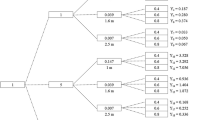Abstract
The purpose of the study was to determine the risks of radiation-induced cancer and deterministic effects for the patient and staff in transarterial chemoembolization (TACE) of hepatocellular carcinoma (HCC). Sixty-five patients with HCC underwent the first cycle of TACE. Thermoluminescence dosemeters and conversion factors were used to measure surface doses and to calculate organ doses and effective dose. For the patient, the risk of fatal cancer and severe genetic defect was in the magnitude of 10−4 and 10−5, respectively. Five patients showed surface doses over the first lumbar vertebra exceeding 2000 mSv and 45 patients showed doses over the spine or the liver region above 500 mSv. The risk of fatal cancer and severe genetic defect for the radiologist and assistant was in the magnitude of 10−7 to 10−8. They could exceed the threshold for lens opacity in the case of more than 490 and 1613 TACE yearly for a period of many years, respectively. Radiation dose could lead to local transient erythema and/or local depression of hematopoiesis in many patients after TACE. For the radiologist and assistant, risk of fatal cancer and genetic defect and lens opacity might arise when they perform interventions such as TACE intensively.
Similar content being viewed by others
References
Bieze J (1993) Radiation exposure risks haunt interventionalists. Diagn Imaging 8:68–79
Wagner LK, Eifel PJ, Geise RA (1994) Potential biological effects following high x-ray dose interventional procedures. J Vasc Intervent Radiol 5:71–84
Food and Drug Administration (1994) Avoidance of serious x-ray induced skin injuries to patients during fluoroscopically-guided procedures. Food Drug Admin 9:1–6
Groupe d´étude et de traitement du carcinome hépatocellulaire (1995) A comparison of lipiodol chemoembolization and conservative treatment for unresectable hepatocellular carcinoma. N Engl J Med 332:1256–1261
Llovet JM, Real MI, Montana X, et al., Barcelona Liver Cancer Group (2002) Arterial embolisation or chemoembolisation versus symptomatic treatment in patients with unresectable hepatocellular carcinoma: a randomised controlled trial. Lancet 359:1734–1739
Lo CM, Ngan H, Tso WK, et al. (2002) Randomized controlled trial of transarterial lipiodol chemomebolization for unresectable hepatocellular carcinoma. Hepatology 35:1164–1171
Drexler G, Panzer W, Widenmann L, et al. (1993) The calculation of dose from external photon exposures using reference human phantom and Monte Carlo methods. III. In: Organ Doses in X-ray Diagnosis. Gesellschaft für Strahlen und Umweltforschung, Munich, Germany
ICRP (1991) Recommendations of the International Commission on Radiological Protection. ICRP Publication 60, Pergamon Press, Oxford
Le Heron JC (1992) Estimation of effective dose to the patient during medical x-ray examinations from measurements of the dose-area product. Phys Med Biol 37:2117–2126
Hart D, Jones DG, Wall BF (1994) Estimation of efefctive dose in diagnostic radiology from entrance surface dose and dose area product measurements. National Radiological Protection Board Report 262: 1–57
Vogl TJ, Trapp M, Schroeder H, et al. (2000) Transarterial chemoembolization for hepatocellular carcinoma: Volumetric and morphologic CT criteria for assessment of prognosis and therapeutic success—Results from a liver transplantation center. Radiology 214:349–357
Hidajat N, Vogl T, Biamino G, et al. (1996) Radiation exposure in interventional radiology as exemplified by the chemoembolization of hepatocellular carcinoma and laser angioplasty of the pelvic arteries. Fortschr Röntgenstr 164:249–256
Ishiguchi T, Nakamura H, Okazaki M, et al. (2000) Radiation exposure to patient and radiologist during transcatheter arterial embolization for hepatocellular carcinoma. Nippon Igaku Hoshasen Gakkai Zasshi 60:839–844
Miller DL, Balter S, Cole PE, et al. (2003) Radiation doses in interventional radiology procedures: the RAD-IR study. Part II: Skin dose. J Vasc Intervent Radiol 14:977–990
Hayashi N, Sakai T, Kitagawa M, et al. (1998) Radiation exposure to interventional radiologists during manual-injection digital subtraction angiography. Cardiovasc Intervent Radiol 21:240–243
Britton CA, Wholey MH (1988) Radiation exposure of personnel during digital subtraction angiography. Cardiovasc Intervent Radiol 11:108–110
Hidajat N, Griesshaber V, Hildebrandt B, et al. (2004) Repetitive transarterial chemoembolization (rTACE) of hepatocellular carcinoma: Comparisons between an arterial port system and conventional angiographic technique. Eur J Radiol 51:6–11
Irie T (2004) Realtime digital magnification of the fluoroscopic and digital subtraction angiography images: Randomized prospective study to show dose reduction during segmental chemoembolization for hepatocellular carcinoma. J Vasc Intervent Radiol 15:165–168
Author information
Authors and Affiliations
Corresponding author
Rights and permissions
About this article
Cite this article
Hidajat, N., Wust, P., Felix, R. et al. Radiation Exposure to Patient and Staff in Hepatic Chemoembolization: Risk Estimation of Cancer and Deterministic Effects. Cardiovasc Intervent Radiol 29, 791–796 (2006). https://doi.org/10.1007/s00270-005-0247-1
Published:
Issue Date:
DOI: https://doi.org/10.1007/s00270-005-0247-1




